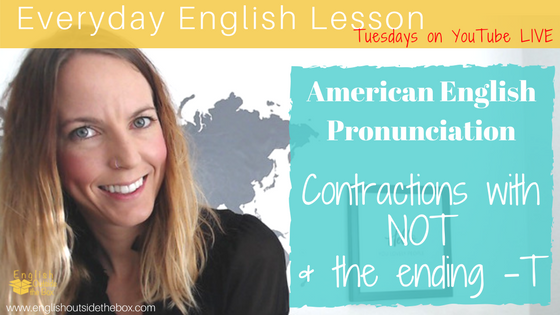
American English Pronunciation: Negative Contractions and the ending -T
The letter “T” in American English is a tricky (*challenging*) sound to master and perfect because of the variations it has when being used in conversations. Did you know there are 4 different ways you can pronounce the “T” [in American English]? Sometimes it can sound like a “T”, or a “D”, while other times it connects to an “N”, or is held and not pronounced at all!
Why are we talking about pronunciation and contractions? Well, it’s pronunciation week in the Conversation Club (my fluency training program) and this week we’re talking about contractions because they are a huge part of becoming a more natural English speaker and getting closer to native-like fluency.
American English Pronunciation: Contractions and the ending -T
Today’s lesson is a more focused lesson that is based on a general review of English contractions, which I’ve already taught in a previous 5-minute English video lesson, “English Contractions”. You can read that full lesson and watch the video here. Other lessons that will help you: “Sound more like a Native Speaker” and “Tag Questions”.
Let’s begin with a review of the “T” sound when it’s at the end of a word.
You may have noticed the difficulty in understanding the difference between American English speakers saying the words “can” and “can’t”. It’s a challenge even for us native speakers. Why? Because the “T” at the end of “can’t” is held, meaning we don’t release it to make that “T” tapping sound when our tongue drops down from behind our top front teeth.
In order to make the ending “T” sound correctly, though, you do need to move your tongue into the T position; however, your tongue will stay there instead of releasing down. Make sure you watch the video replay if you haven’t yet to review how this position looks.
Other examples of words that end in a “T” sound:
not, don’t, want, can’t, cat, boat, great
Contractions with NOT
As you can see in the above examples, we have the contractions “don’t” and “can’t”. There are so many more though and these contractions are going to be incredibly common in conversations. You’ll be using these negative contractions in negative sentences and with tag questions. Which are really common, aren’t they?
So I recommend re-watching today’s video lesson to review the sound and mouth position of the following contractions in American English:
DO
- don’t – I don’t go.
- doesn’t – He knows, doesn’t he?
- didn’t – We didn’t want to.
BE
- isn’t – That’s crazy, isn’t it?
- aren’t – They aren’t doing that.
- wasn’t – She was there, wasn’t she?
- weren’t – I can’t believe you weren’t there.
HAVE
- haven’t – I haven’t been there.
- hasn’t – He hasn’t called yet.
- hadn’t – We’d been there, hadn’t we?
MODALS
- won’t – I won’t think about it.
- wouldn’t – You wouldn’t believe that.
- can’t – We can go, can’t we?
- couldn’t – She couldn’t hear you.
- shouldn’t – You shouldn’t eat that.
*NOTE: might and must are not often used negatively as contractions in conversations, so not highlighted here as we focus on common, everyday English use!
Practice Makes Perfect
The key to practicing pronunciation is to use it! The first step…and only the first is reviewing the information you are today in this lesson and video (replay). Step 2 is practicing and step 3, 4, 5….etc is using it naturally and confidently in your own conversations!
You can do this practice on your own, just make sure you are recording yourself with some audio recording device so you can check to make sure you are producing the right sounds. Compare the audio to mine or give it to your teacher to review.
What would be even better is to practice with a conversation partner and a native speaking English teacher for guidance and feedback. This is exactly what you get in the Conversation Club. The Conversation Club is my online fluency training program that gives you new weekly material to improve your conversation skills, speak better English and sound more natural and confident! As I mentioned at the start of this lesson, we are focused even more on contractions this month, as well as other important pronunciation topics in American English. Did you know the contraction with YOU has 3 different sounds? What are these differences and how can you practice them?
Join the Conversation Club today to find out and get connected to a conversation partner to practice speaking, join a conversation meetup, and practice English with me LIVE in a group conversation call this week! Plus you’ll learn how to say and use 14 new phrasal verbs and idioms naturally.
Sign up by clicking here or enter your name and details below for more information and practice material.
Happy Studying! ♥
The Conversation Club will provide you with 6 group conversation calls to practice with a real teacher and a group message community to connect with other members.
You will also get weekly English lessons to help your vocabulary, listening, reading, pronunciation, and more!
Try the Club for 1 week, free! Join the 1-week free trial here.
